Clownfish, scientifically belonging to the subfamily Amphiprioninae, have become emblematic of marine life diversity due to their striking coloration and symbiotic relationships. Known to inhabit the warm waters of the Pacific and Indian Oceans, these fish have gained popularity among marine biologists and aquarium enthusiasts alike. Yet, one question frequently arises: “How long does a clownfish live?”
According to a study published in the “Marine Biology” journal, clownfish have a lifespan that significantly differs based on their environment. In the wild, they typically live between 6 and 10 years, navigating threats of predation, disease, and food scarcity. However, in captivity, their lifespan can extend up to 18 years given optimal conditions.
This substantial difference can be attributed to various factors, including their unique social structures, species-specific characteristics, and the impact of human intervention. This article unfolds the multifaceted story of clownfish lifespan, providing insights into the unique life histories of these remarkable creatures.
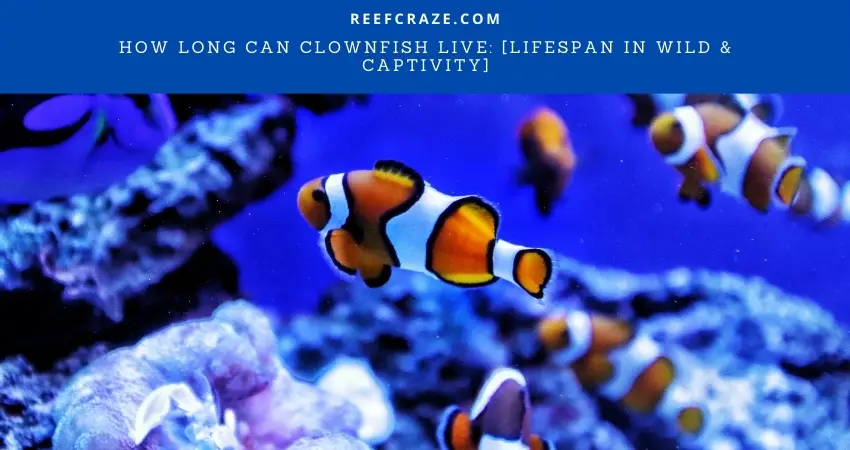
What is the Typical Lifespan of a Clownfish?
The lifespan of a clownfish can be highly variable. In the wild, clownfish are known to live for around 6 to 10 years on average, although some species have been known to live up to 15 years under optimal conditions. In contrast, in the confines of a well-maintained aquarium, their lifespan can extend significantly, averaging between 7 and 12 years, with some recorded instances of clownfish living up to 18 years.
Lifespan of Clownfish in the Wild
In their natural habitat, clownfish face a host of survival challenges including predation, diseases, and fluctuations in food availability. Despite these, clownfish exhibit robust survival strategies, such as their mutualistic relationship with sea anemones, enabling them to reach an average lifespan of 6 to 10 years. Exceptional cases exist where wild clownfish have been reported to live for as long as 15 years.
Lifespan of Clownfish in Captivity
In contrast, captive clownfish tend to have a longer lifespan, primarily due to the absence of predators, consistent food supply, and the potential for professional healthcare. They generally live between 7 to 12 years, and under ideal conditions, they can reach an age of 18 years or more.
More information: Arne Sahm et al. Analysis of the coding sequences of clownfish reveals molecular convergence in the evolution of lifespan, BMC Evolutionary Biology (2019). DOI: 10.1186/s12862-019-1409-0
How Does the Environment Influence the Lifespan of Clownfish?
Environment plays a pivotal role in determining the lifespan of a clownfish. This holds true for both natural and artificial environments. The symbiotic relationships they form, the threats they encounter, and their access to sustenance greatly influence their longevity.
Natural Habitats and their Impact on Clownfish Longevity
1. Reef and Anemone Associations: The life of a clownfish is intrinsically tied to coral reefs and sea anemones. Clownfish form a mutualistic relationship with certain species of sea anemones, each providing significant benefits to the other. This relationship not only offers the clownfish protection from predators but also gives them exclusive feeding rights to the anemone’s leftovers, thereby ensuring a consistent food supply.
2. Food Availability: In the wild, clownfish primarily feed on small invertebrates, algae, zooplankton, and leftovers from their anemone partners. The abundance and availability of these food sources significantly influence their growth, health, and ultimately, their lifespan.
3. Predation and Threats: Predation is a constant threat for wild clownfish. They are preyed upon by larger fish, eels, and sharks. Their unique relationship with anemones provides a degree of protection, but it’s not absolute. Predation, along with other threats like habitat destruction, can reduce their lifespan.
Captive Environments and Clownfish Lifespan
1. Tank Conditions and Maintenance: In captivity, a well-maintained tank simulates a clownfish’s natural habitat and can significantly enhance their lifespan. Key factors include proper temperature regulation, suitable pH levels, and adequate light exposure. Regular water changes to remove waste and toxins also contribute to their health and longevity.
2. Nutrition in Captivity: In aquariums, clownfish have a varied diet that includes flakes, pellets, and live or frozen invertebrates. A balanced diet is critical to ensure they receive all the necessary nutrients for optimal growth and longevity.
3. Common Diseases in Captivity: Despite the controlled environment, clownfish in captivity are susceptible to several diseases, such as Marine Ich and Brooklynellosis. Early detection and appropriate treatment can prevent these diseases from shortening the lifespan of captive clownfish.
How Do Clownfish Species Differ in Lifespan?
Clownfish comprise about 30 different species, each with distinct characteristics and lifespans. Let’s delve into the lifespan of some popular clownfish species.
The below table represents the Results of the clownfish survey. The longest-lived individual for each species is indicated.
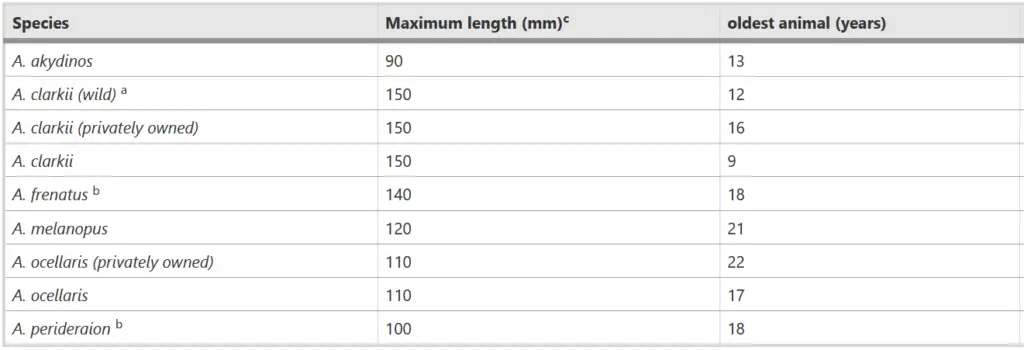
- Orange Clownfish (Amphiprion percula): Commonly known as the “Nemo” fish, the Orange Clownfish typically lives between 6 to 10 years in the wild. In captivity, their lifespan extends to 7-12 years given appropriate tank conditions and nutrition.
- Maroon Clownfish (Premnas biaculeatus): Maroon Clownfish are renowned for their striking color and larger size. Their lifespan in the wild ranges from 5-7 years. In captivity, with optimal conditions, they can live between 8 to 10 years.
- Tomato Clownfish (Amphiprion frenatus): Known for their vibrant red color, Tomato Clownfish have a lifespan of 6-8 years in the wild. In captivity, they can live up to 7-11 years.
Factors Influencing Lifespan Variations Among Species
Various factors account for the lifespan variation among different clownfish species. These include inherent genetic traits, dietary preferences, and species-specific behaviors and tolerances to environmental stressors.
How Does Clownfish Behavior Affect Their Lifespan?
Clownfish exhibit a variety of unique behaviors, from their hierarchical social structures to their mating rituals, which can influence their lifespan.
The Role of Social Structure in Clownfish Lifespan
- Hierarchical System: In the wild and in larger aquarium settings, clownfish form complex social hierarchies that play a role in their lifespan. There is typically one dominant female in a group, and when she dies, the largest male transforms into a female to take her place. This unique structure minimizes conflict and stress, promoting longevity.
- Effect of Stress from Social Dynamics: Despite the stability of their hierarchies, social stress can impact clownfish. Smaller, subordinate clownfish may experience stress-related health issues, potentially shortening their lifespan.
Reproduction and its Impact on Clownfish Lifespan
Clownfish are sequential hermaphrodites, meaning they can change their sex during their lifetime. This unique reproductive strategy can influence their lifespan as they expend energy during the transformation process. Additionally, the energy expended in breeding and egg care can also impact their longevity.
How To Increase Clownfish Lifespan in Captivity?
Every clownfish indeed has a different lifespan. But with proper care and providing other essential things, you can increase your clownfish’s lifespan. Here are a few tips that you can follow.
Use The Right Tank: Decent Size is Important
Just because a clownfish grows only 3-5 inches does not mean it will be fine in a small tank. Remember that some clownfish grow longer than that. Using a bigger tank helps the fish move more freely.
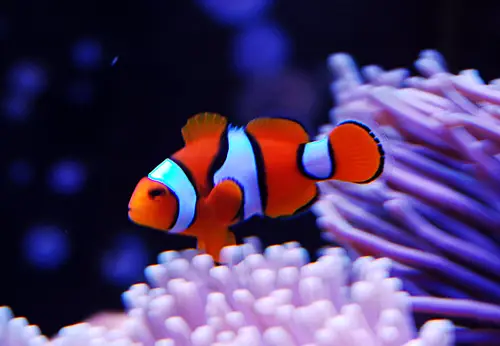
Though some people agree that a clownfish can live in a 10-gallon tank, I believe you should use a 20-gallon tank to create a vast swimming area for the fish. Besides, if the tank is too small, the fish can die from ammonia poisoning. Another benefit of using a large tank is that it will not require frequent cleaning.
Ensure Suitable Water Condition
As you already know, clownfish are saltwater fish. To be more specific, they are warm saltwater fish and do not survive in fresh or cold water environments. That’s why you need to have a saltwater aquarium before you purchase the fish.
To ensure the water condition is suitable, keep the pH level between 8-8.4, and the nitrites quantity should be 0.2ppm. The water temperature needs to be 70 to 80 degrees Fahrenheit.
Add salt and other essential elements to keep everything in balance. And don’t forget to test the water at least once a week.
No Non-Compatible Tank Mates
Clownfish can live alone without any issue. But if you want to add some tank mates, think again. Clownfish live in warm salt water, which is not suitable for many fish.

Moreover, if you add a big or aggressive fish, it will end up killing your clownfish. So instead of that, you can add corals or anemones to the tank. Keep an eye on the fish’s behavior after you introduce it to the newest additions.
Right Tank Setups
I have already discussed most of the things you need to know about the proper tank setup. Your clownfish will be fine as long as it is a saltwater tank with a balanced pH and nitrites level.
But if you want to keep the fish more active and stress-free, you can decorate it with corals, stones, anemones, and plants. It will give the fish a safe feeling and a place to hide sometimes. Make sure to add light for the clownfish to see its food.
4 Common Clownfish Diseases That Can Reduce It’s Lifespan
It is not uncommon for clownfish to get ill from time to time or catch a disease. The main thing is to be able to identify them immediately. If you can, you can give the fish the treatment it needs and help it live longer.
1. Fin Rot:

Stress or getting bullied by other fish can lead to fin rot. It appears like reddening or fraying in the fin and can spread over time. So the solution is to keep the fish quarantined in another tank and give it medical attention.
2. White Spots:
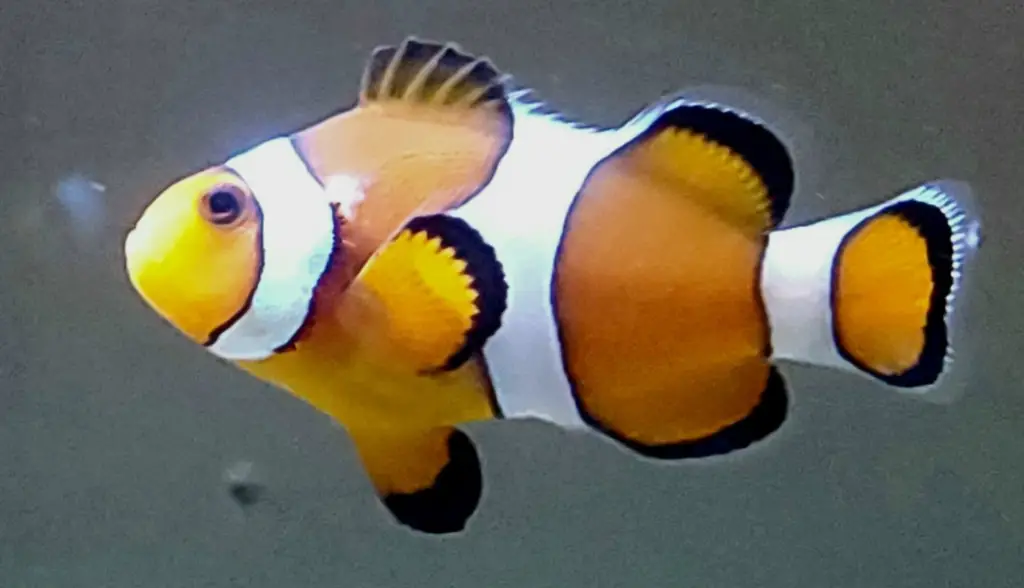
It is wrong to think that fish do not get a fungal infection. It causes white spots all around the fish’s body and can affect other tank fish. The treatment for such a disease includes adding salinity and rising water temperature.
3. Hole In The Head:
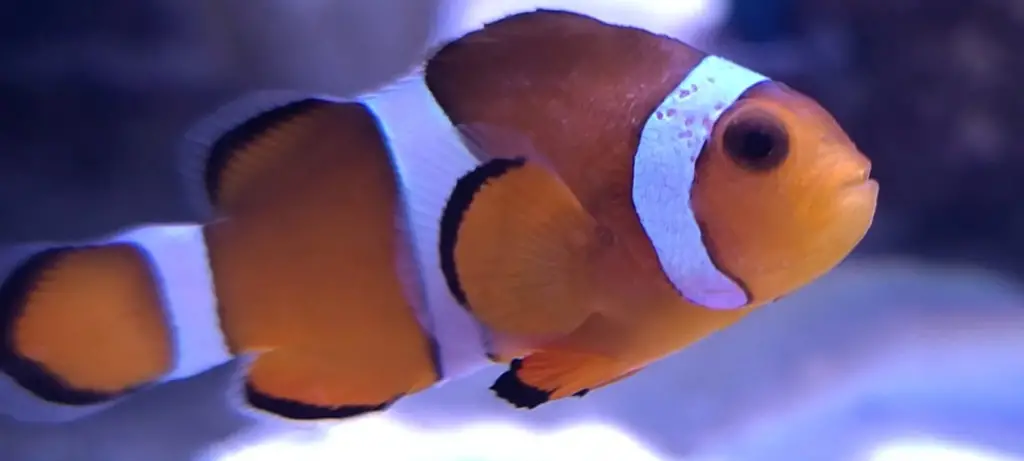
This disease happens due to a type of parasite. The affected area will appear lateral, black, white, or other colors. In the beginning, you will notice pin-sized holes, but they will keep spreading. It is not treatable at home. So, it would be best if you visited a vet for the solution.
4. Swim Bladder Disorder:

If you notice the fish is swimming slowly or having difficulty moving, it can be a swim bladder issue. Increase the tank temperature and stop feeding the fish if the stomach is swelling.
Read Next: How to feed clownfish
Frequently Asked Questions
Do Clownfish Need Saltwater?
How Much Do Clownfish Cost?
But you should know that there are various types of clownfish. Their price depends on that, along with their color, size, and availability. If you purchase a less common or more rare clownfish, the cost can be up to $150.
Do Clownfish Need Anemones?
Yes, the symbiotic relationship between clownfish and anemones helps them survive in the wild. However, tank clownfish can live without them. But you can add the anemones in the tank to give the fish a natural and safe feeling.
How To Maintain Clownfish?
The key to maintaining clownfish is to have enough knowledge about them. Since they are saltwater fish, the more knowledge and experience you have, the better. So research well before you get yourself a clownfish.
May Your Clownfish Live A Healthy & Happy Life
You never know what to expect when it comes to the lifespan of a pet animal or a fish. Clownfish are warm saltwater fish of the ocean. So when you keep them in the fish tank, it is best to know how long can clownfish live or what can help them live longer.
To ensure a long life for your clownfish, purchase the ones you can commonly find in the stores. If the clownfish is directly from the sea, it will not adapt and survive a long time in the aquarium.
